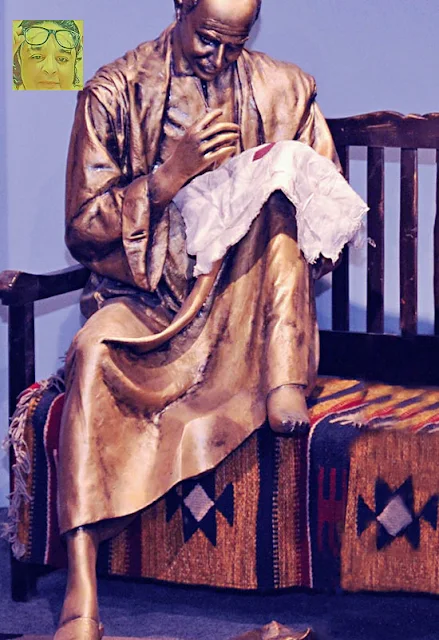Preserving
and Celebrating Egypt's
Cultural Tapestry: The Museum
of Folk Arts and Heritage
Nestled
within the Higher Institute of Folk Arts at the Academy
of Arts in Egypt
lies a treasure trove of cultural heritage – the Museum of Folk Arts
and Heritage. This expansive space, encompassing 2000 square meters, serves as
a vibrant testament to the rich tapestry of Egyptian traditions and rituals,
offering visitors a captivating journey through the country's history and
diverse cultural landscape.
 |
| Preserving and Celebrating Egypt's Cultural Tapestry: The Museum of Folk Arts and Heritage |
A
Window into Egyptian Life:
Stepping
into the museum is akin to stepping into a time capsule, where scenes from
everyday life across Egypt
unfold before your eyes. The exhibits capture the essence of various
communities and their unique customs, creating a mosaic of experiences that
define the Egyptian identity.
dedicated to showcasing the deep-rooted religious practices of the Egyptian people. The Hajj pilgrimage, a cornerstone of the Islamic faith, is vividly depicted, with exhibits portraying pilgrims adorned in traditional attire, singing evocative songs like "Rahiha fein ya Hajja ya Om shal qatifa" ("Where are you going, pilgrim woman with the velvet shawl?") and "Ya rayheen lel Nabi el ghali" ("Oh those going to the beloved Prophet"). These scenes are complemented by verses from the Quran, reminding visitors of the spiritual significance of this journey.Religious Observances:

Scenes
from Daily Life: The museum masterfully captures the essence of daily life in Egypt,
transporting visitors to bustling marketplaces, serene rural landscapes, and
intimate domestic settings. The vibrant atmosphere of local cafes is recreated,
with patrons engaged in animated conversation over cups of tea. The age-old
tradition of fishing is depicted through meticulously crafted models of
fishermen casting their nets into the Nile.
The sights and sounds of street vendors hawking their wares, from juicy
watermelons to the sweet aroma of freshly baked kunafa, fill the air. The
meticulous process of khayamiya embroidery, a traditional craft used to
decorate tents, is showcased, demonstrating the intricate skills passed down
through generations. Even the simple act of baking bread in a rural home is
given its due, highlighting the significance of this staple food in Egyptian
culture.

Historical
Echoes: The museum transcends the boundaries of everyday life to encompass
pivotal historical events that have shaped Egypt's identity. One such event is
the annual procession of the Mahmal, a richly decorated camel caravan that
historically carried the kiswah, the elaborately embroidered cloth used to
cover the Kaaba in Mecca.
The exhibit captures the grandeur of this tradition, showcasing the ornate
textiles and ceremonial objects associated with the Mahmal.
A
Feast for the Senses:
The
museum experience goes beyond visual appreciation, engaging multiple senses to
create a truly immersive environment. The lifelike poses of the statues and the
intricate details of the exhibits bring the past to life, allowing visitors to
connect with the emotions and experiences of the people depicted. The
incorporation of traditional music and chants adds another layer to the sensory
experience, transporting visitors to different regions and occasions. The
sounds of devotional songs, lively market chatter, and rhythmic folk tunes
evoke a sense of place and time, fostering a deeper understanding of Egyptian
culture.
Preserving
Traditions for Posterity:
The
Museum of Folk
Arts and Heritage plays a crucial role in safeguarding Egypt's
cultural heritage for future generations. As Dr. Samar Saeed, Dean of the
Higher Institute of Folk Arts, emphasizes, the museum actively works towards
preserving traditional crafts and rituals through educational initiatives and
workshops. Skilled artisans share their knowledge with younger generations,
ensuring the continuity of age-old techniques like palm weaving and khayamiya
embroidery. By fostering appreciation for these traditions, the museum
safeguards a vital part of Egypt's
cultural identity.
A
Promising Future:
The
museum is poised to reach a wider audience with the upcoming grand opening
ceremony, welcoming visitors from all walks of life to experience the richness
of Egyptian culture. The planned workshops on traditional crafts and rituals
will further enhance the museum's role as a center for cultural preservation
and education.
The
Museum of Folk Arts and Heritage stands as a
testament to the enduring legacy of Egyptian culture. Its diverse exhibits
offer a captivating glimpse into the lives, traditions, and values of the
Egyptian people, fostering understanding and appreciation for this rich and
vibrant culture. By preserving these traditions for posterity, the museum
ensures that future generations can continue to draw inspiration and pride from
Egypt's
cultural tapestry.








